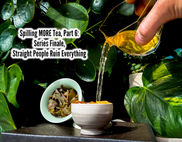14 Year Old Bu Lang Brick!
- The Oolong Drunk
- Mar 12, 2017
- 3 min read
Hello hello!
Yunnan Sourcing is a staple for buying puer teas online, especially aged puer. One thing that amazes about the owner Scott is his ability to acquire so many different teas in such a short period of time. Some of these teas are his own, but most of them come from other places. One of those teas is a fourteen year old raw puer brick. Scott explained that the brick was made fourteen years ago for a puer seller, and after the deal fell through, they sat in a warehouse until he found them. After a year of negotiating and trying to acquire this brick, Yunnan Sourcing was able to obtain a small amount to sell on their site.
Now that this brick made its way to the United States, I was able to get ahold of a sample to try for myself. This just happens to be the oldest sheng puer that I’ve tried to date, and curiosity was getting the best of me. So what would any sane person do? Eat it? No way — this isn't Cha Gao. But instead, here’s what to expect when you (figuratively) brew this teenager of a Bu Lang brick…

Steeps 1 - 4
For this session, I measured 6.6g of this brick to brew in a 100ml vessel, with a temperature of 185ºf. After a quick rinse, the first steep was quickly on its way. At first, a very prominent base flavor of leather skid across the tongue - which is a sign of long-term humid storage. The notes of leather were laced with bright hints of apricots, and tapered off with a minty finish. As the infusions went on, the tea quickly got thicker and more powerful. After the fourth infusion, this tea felt medicinal because of its leatheriness. By the end of the fourth steep, my lips were tingling because of how thick Bu Lang’s soup was. Despite this tea’s power, it was also calming and relaxing because all of the tasting notes flowed together beautifully.

Steeps 5 - 8
By the fifth infusion, this tea’s body took on a velvety texture that closely resembled beef broth. The brick slowly took on an astringent mouthfeel which left a viscous sweetness behind in its shadows. Bu Lang started to lose its apricot tasting notes, and was feeling rougher than it had before. Unlike the previous steeps, the tea was opening up in a way that its energy hit you in the face like a pissed off girlfriend whose throwing your stuff at you— Oh you know, some of you have been there before.

Steeps 9 - 12
Bu Lang was rounding off its sweetness and quickly took on a bitter base, which was mixed with its leathery body. As the steeps went on, more and more of this tea’s body took on an earth-like texture, which reminded me of shou puer. The taste of earth resembled wood and dirt. The soup’s texture was starting to mellow out around the twelfth infusion, but still showing strong signs of humid storage — which was more evident due to its musky after taste. The notes of leather were still clear, and still present until the last steep. However, the sweetness and the fruitiness disappeared altogether. Because of this tea’s roughness, I figured it was best to end the session here.

Conclusion
2003 Bu Lang was a great example of how an aged tea should taste. This tea showed clear signs of being stored in a humid climate, which may or may not be pleasant for all. 2003 Bu Lang started out incredibly strong, and was a great experience starting out. The tasting notes were so clear and crisp that you could easily detect them one by one. However, I was a little disappointed how quickly it lost its sweetness and how fast it became rough.
Overall, I don’t think that aged puer is for everyone, but if you’re an aged puer enthusiast, this brick should definitely be added to your list of aged teas to try. With everything, this brick is set at an incredible price point, especially given how clean and how old this tea is. Yunnan Sourcing continues to provide excellent examples of how clean and well preserved an aged tea should be. So next time you’re about to place an order, be sure to drop some of this tea in your cart, because this is one experience worth having. Theres nothing like drinking an aged tea with a history behind it…























Comments